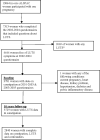The Association Between Constipation and Lower Urinary Tract Symptoms in Parous Middle-Aged Women: A Prospective Cohort Study
- PMID: 33434452
- PMCID: PMC8403183
- DOI: 10.1089/jwh.2020.8624
The Association Between Constipation and Lower Urinary Tract Symptoms in Parous Middle-Aged Women: A Prospective Cohort Study
Abstract
Objective: To examine the prospective association between constipation and risk of developing lower urinary tract symptoms (LUTS) in parous middle-aged women. Materials and Methods: The study uses data from 3,729 women from the Avon Longitudinal Study of Parents and Children who provided self-reports of medication intake for constipation at two time points (Baseline): 2001-2003 and 2003-2005. Women with LUTS at baseline were excluded. After 10 years of follow-up, women provided self-reports of LUTS using an adapted version of the International Consultation on Incontinence Questionnaire on Female LUTS. LUTS were categorized according to International Continence Society definitions as stress urinary incontinence (UI), urgency UI, mixed UI, nocturia, increased daytime frequency, urgency, hesitancy, and intermittency. LUTS were considered present if symptoms were reported to occur at least "sometimes" for all subtypes, except for increased daytime frequency (≥9 times) and nocturia (≥2 times nightly). Results: At follow-up, the prevalence of any LUTS was 40%. Women (mean age 43.3 years, standard deviation 0.5), who took medication for constipation at either time point had increased risks of urgency (adjusted relative risks [RRs] = 1.35; 95% confidence interval [CI] 1.04-1.95) and hesitancy (adjusted RR = 1.72; 95% CI 1.04-3.01) compared with women who reported not using medication for constipation at either time point. The risk of urgency (adjusted RR = 1.94; 95% CI 1.15-3.29) and hesitancy (adjusted RR = 1.78; 95% CI 1.03-4.19) was greater for women who reported taking medication for constipation at both time points. There was no evidence that constipation was associated with stress UI, urgency UI, mixed UI, nocturia, increased daytime frequency, and intermittency. Conclusion: Constipation is prospectively associated with an increased risk of urgency and hesitancy among parous middle-aged women. If further research finds evidence that this association is causal, this implies that women should seek treatment to alleviate constipation to reduce their consequent risk of developing these LUTS.
Keywords: ALSPAC; LUTS; constipation; urinary incontinence; women's health.
Conflict of interest statement
No competing financial interests exist.
Figures
Similar articles
-
Bidirectional relationships between depression, anxiety and urinary symptoms in women: A prospective cohort study.J Affect Disord. 2025 Jan 15;369:516-522. doi: 10.1016/j.jad.2024.10.035. Epub 2024 Oct 10. J Affect Disord. 2025. PMID: 39393464
-
Bowel function, sexual function, and symptoms of pelvic organ prolapse in women with and without urinary incontinence.Neurourol Urodyn. 2018 Nov;37(8):2586-2596. doi: 10.1002/nau.23587. Epub 2018 Apr 10. Neurourol Urodyn. 2018. PMID: 29635702 Free PMC article.
-
The association of fecal incontinence, constipation, and pelvic pain with the course of lower urinary tract symptoms in community-dwelling men and women.Neurourol Urodyn. 2024 Sep;43(7):1566-1573. doi: 10.1002/nau.25492. Epub 2024 May 23. Neurourol Urodyn. 2024. PMID: 38779984
-
Constipation and LUTS - how do they affect each other?Int Braz J Urol. 2011 Jan-Feb;37(1):16-28. doi: 10.1590/s1677-55382011000100003. Int Braz J Urol. 2011. PMID: 21385476 Review.
-
Pelvic floor muscle training versus no treatment, or inactive control treatments, for urinary incontinence in women.Cochrane Database Syst Rev. 2018 Oct 4;10(10):CD005654. doi: 10.1002/14651858.CD005654.pub4. Cochrane Database Syst Rev. 2018. PMID: 30288727 Free PMC article.
Cited by
-
The relationship between pelvic floor distress and sexual function in women with urinary incontinence.Rev Assoc Med Bras (1992). 2025 Jun 2;71(4):e20241846. doi: 10.1590/1806-9282.20241846. eCollection 2025. Rev Assoc Med Bras (1992). 2025. PMID: 40466000 Free PMC article.
-
Prevalence of recurrent urinary tract infections and its associated factors in female staff of reproductive age group in a medical college in central Kerala: a cross-sectional study.BMC Infect Dis. 2025 Feb 25;25(1):276. doi: 10.1186/s12879-025-10634-x. BMC Infect Dis. 2025. PMID: 40000942 Free PMC article.
-
Management of mixed urinary incontinence: IUGA committee opinion.Int Urogynecol J. 2024 Feb;35(2):291-301. doi: 10.1007/s00192-023-05694-z. Epub 2024 Jan 22. Int Urogynecol J. 2024. PMID: 38252279 Free PMC article. Review.
-
Underactive bladder as defined by the International Continence Society in the 2023 Japan Community Health Survey.Int J Urol. 2025 Jan;32(1):51-59. doi: 10.1111/iju.15595. Epub 2024 Oct 9. Int J Urol. 2025. PMID: 39382059 Free PMC article.
References
-
- Haylen BT, De Ridder D, Freeman RM, et al. . An International Urogynecological Association (IUGA)/International Continence Society (ICS) joint report on the terminology for female pelvic floor dysfunction. Neurourol Urodyn 2010;29:4–20 - PubMed
-
- Riss P, Kargl J. Quality of life and urinary incontinence in women. Maturitas 2011;68:137–142 - PubMed
-
- Pereira MG, Lynch B, Hall-Faul M, Pedras S. Quality of life of women with urinary incontinence in rehabilitation treatment. J Health Psychol 2019;24:254–263 - PubMed
-
- Bartoli S, Aguzzi G, Tarricone R. Impact on quality of life of urinary incontinence and overactive bladder: A systematic literature review. Urology 2010;75:491–500 - PubMed
Publication types
MeSH terms
Grants and funding
LinkOut - more resources
Full Text Sources
Other Literature Sources
Medical

